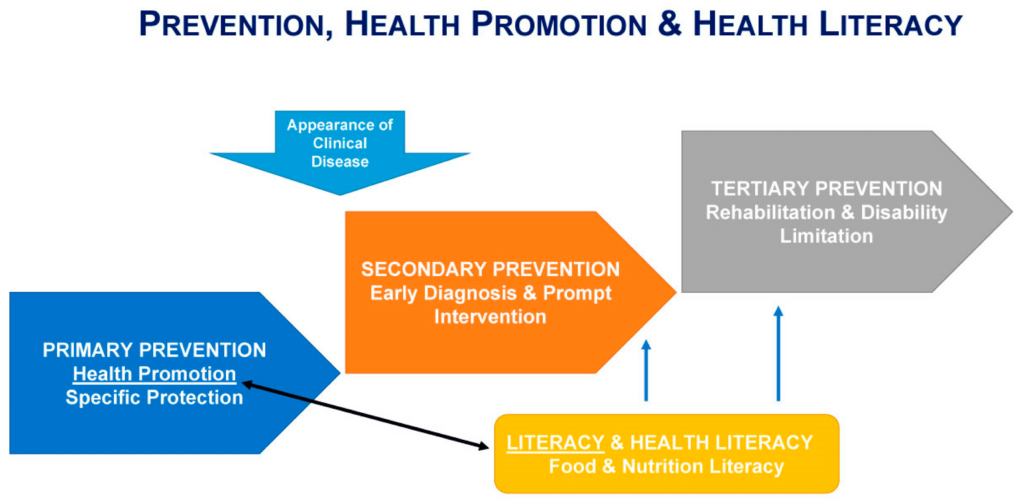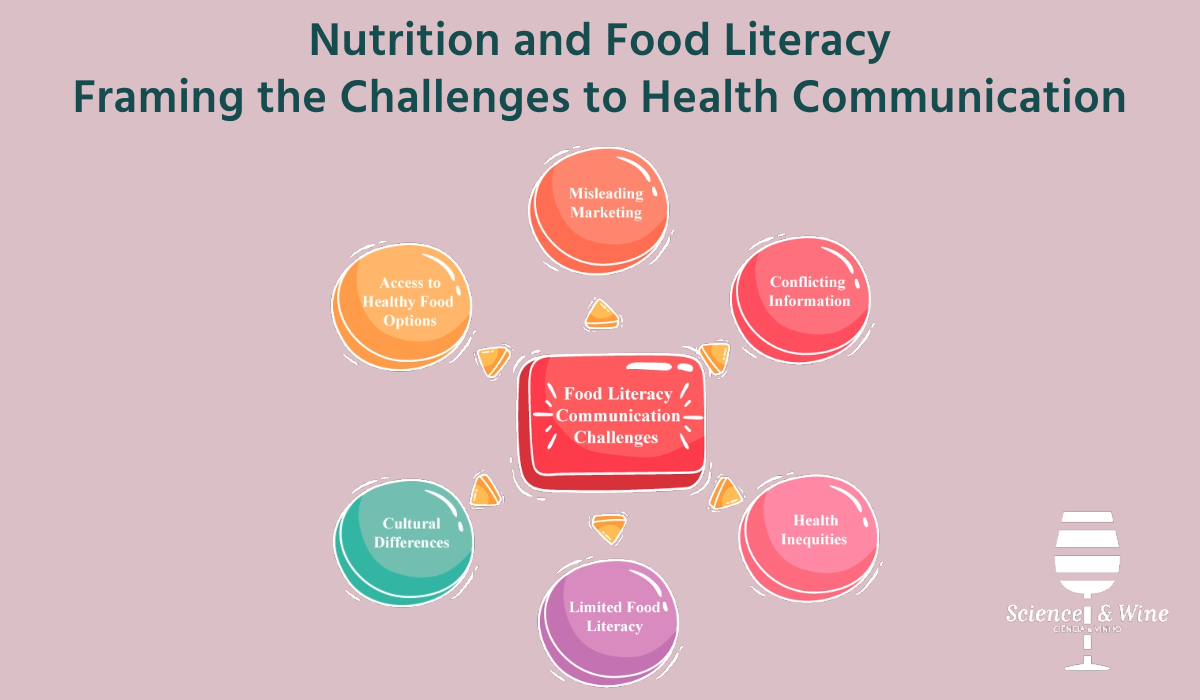by Paula Silva, Rita Araújo, Felisbela Lopes and Sumantra Ray
In the intricate world of wellness, the terms “nutrition” and “food literacy” often dance together, but they possess distinct rhythms. While nutrition is related to the scientific exploration of how food affects our bodies, food literacy extends beyond embodying the knowledge, skills, and attitudes essential for making informed decisions about what we eat and its profound implications on our health.
This week, our blog journey ventures into the heart of this symbiotic relationship, unraveling the tapestry that binds nutrition and food literacy. Despite the growing recognition of the latter’s significance, a global concern looms large—food illiteracy. It extends its reach across age, background, and socioeconomic status, weaving a complex narrative with far-reaching health implications, particularly for vulnerable populations.
Join us, as we navigate the intricate landscape of food literacy, dissecting its multidisciplinary nature and addressing the challenges that hinder effective health communication. Within these challenges lies the key to dismantling health inequities and cultivating a society in which every individual, regardless of their background, possesses the knowledge to make nourishing choices. At its core, addressing food illiteracy is not just a health imperative; it is a step toward promoting equity and fostering healthier outcomes.
Welcome to this week’s exploration, where knowledge nourishes and understanding flourishes.

In a world inundated with information on nutrition and health, individuals often find it challenging to make informed decisions regarding their dietary choices. The scientific paper under consideration delves into critical issues of food literacy and the importance of differentiating between nutrition and food literacy. The paper emphasizes the global impact of food illiteracy on health outcomes, especially when coupled with factors such as poverty and limited access to nutritious food. The authors explored the evolution of the concept of nutrition literacy, tracing its roots to a 1995 study that assessed the nutrition knowledge of healthy Canadians. They highlighted the three levels of health literacy proposed by Don Nutbeam: functional, communicative/interactive, and critical. These levels emphasize not only basic understanding, but also the ability to seek, analyze, and critically assess health information. Crucially, this study clarifies the distinction between nutrition and food literacy. Nutrition literacy involves understanding nutritional principles and being able to interpret and use nutritional information to make healthy choices. On the other hand, food literacy encompasses a broader set of skills, including decision-making, handling, choosing, cooking, and eating food. The authors advocate the use of “food literacy” as it encapsulates the skills necessary for responsible eating behavior. The authors referred to various models of food literacy, such as Vidgen’s eight domains and Truman et al.’s six core themes, highlighting the multifaceted nature of this concept. They stress the importance of measuring food literacy skills, including reading, understanding, and analyzing information, as well as evaluating the factors influencing individual food choices and their societal impact. This study underscores the critical role of health, food, and nutrition literacy in different levels of disease prevention. From promoting healthy lifestyles to managing chronic conditions and preventing complications, literacy in these areas is essential. The integration of nutritional literacy into the broader context of health and food literacy is a central theme. This comprehensive approach emphasizes that nutrition literacy extends beyond acquiring knowledge and interpreting food labels. It encompasses a wider social, cultural, and political context, operating at personal, interpersonal, and societal levels. This holistic understanding has the potential to lead to healthier individuals and contribute to a more sustainable global community. This study advocates for a comprehensive conception of nutrition literacy that incorporates the crucial components of health and food literacy. This integration is vital in providing individuals with a profound understanding of the significance of nutrition in their lives and its broader implications for health and sustainability.
The paper emphasizes the relationship between the rise in non-communicable diseases and the increase in food illiteracy. This is attributed to a lack of knowledge regarding navigating complex food systems and adhering to nutritional recommendations. The 21st-century “nutrition transition” is characterized by the prevalence of processed and ultra-processed, low-nutrient, and energy-dense foods, leading to a decline in cooking skills. Factors contributing to food illiteracy include lack of education about healthy eating, limited access to affordable healthy food, time constraints for cooking, insufficient knowledge about meal preparation, and high levels of stress. Food illiteracy has become a global issue driven by misinformation about food and its health effects. There are two types of food illiteracy: one in which people lack knowledge about certain foods and their preparation, and the other in which individuals have a poor understanding of the nutritional value of foods and struggle to balance meals. This lack of knowledge has resulted in alarming rates of obesity and diabetes with potential cascading effects on cardiovascular and kidney health. Children’s food literacy rates are particularly low, with many schools relying on parents to provide meals, which often leads to unhealthy snack choices. Improving healthy eating habits in early life is crucial as this period significantly influences lifelong habits and health outcomes in adulthood. The study suggests that governments should invest more in educating children about healthy eating habits at school to promote lifelong positive choices.
This study explores the relationship between food literacy and health outcomes, emphasizing that individuals lacking basic knowledge about food are more susceptible to obesity, heart disease, diabetes, and cancer. Health inequities, defined as differences in health status arising from social conditions, play a significant role in shaping food literacy. These inequities persist across all life stages and are influenced by factors such as race, ethnicity, sex, and socioeconomic status. Disadvantaged populations are more likely to suffer from food-related health inequities owing to limited access to healthy foods and information about healthy diets. This study emphasizes the importance of food literacy programs, particularly for vulnerable groups, to address health disparities. Educational programs should focus on improving food literacy among populations with lower education levels to reduce global health inequities, ensuring access to nutritious foods, and knowledge about their preparation.

Figure 1. Health, nutrition, and food literacy play a critical role in the prevention and management of diseases across all stages of prevention. The authors acknowledge NNEdPro for the figure conceptualization.
The multifaceted nature of these challenges is comprehensively examined, encompassing the influence of the media, personal experiences, and online platforms. This study draws attention to the rapid dissemination of information through the Internet and social media, underscoring the difficulties faced by health authorities in countering false claims and maintaining the accuracy of information. Several noteworthy aspects are highlighted, including the role of various entities, such as food and beverage companies, individuals, and organizations in spreading disinformation for financial interests. The impact of such disinformation is emphasized, ranging from promoting unhealthy products to making false claims about the health benefits of certain ingredients. This study stresses the importance of scientific literacy in evaluating nutritional information and the prevalence of conflicting information, making it challenging for individuals to determine what constitutes a healthy diet. The necessity of ongoing efforts to address these challenges is emphasized, with a call for health organizations to provide credible evidence-based information and promote scientific literacy. Health professionals and nutrition experts should be vigilant in countering misinformation. Additionally, this study underscores the role of social media companies and online platforms in curbing the spread of disinformation by promoting credible sources and limiting false claims.
The subsequent section of this study transpires to the broader context of health communication, elucidating historical perspectives on its definition and evolution over time. The various definitions articulated by various scholars substantiate the dynamic nature of health communication, encompassing communication approaches to inform and influence decisions for individual and global health. The study then narrows its focus to nutrition and food communication, accentuating the indispensable role of effective communication in influencing healthy eating behaviors. Drawing parallels with social marketing principles, it underscores the application of marketing strategies to promote behavioral change and improve health outcomes. This study explores the multi-level nature of food communication, spanning the individual, organizational, and societal levels, as researchers examine dynamics across these dimensions. Moreover, this study emphasizes the significance of considering cultural, social, and economic backgrounds in food communication, emphasizing the need for accurate, science-based, and unbiased information. Governmental agencies have been identified as key players in promoting food literacy through policy changes, such as taxes on unhealthy foods and subsidies for fresh produce. This study stresses the importance of clear and concise food labeling to empower consumers to make informed choices. Furthermore, the study advocates for educational initiatives such as encouraging people to grow their own food, teaching cooking skills, and incorporating food literacy education into curricula. Additionally, it highlights the role of public education campaigns in raising awareness of healthy eating habits.

This study examined the digital landscape, focusing on the utilization of online resources, websites, blogs, and social media to disseminate information regarding food, nutrition, and healthy eating. While recognizing the potential of digital interventions in reaching diverse populations, this study stresses the importance of tailoring approaches to specific target groups. In the healthcare realm, effective communication is recognized as a crucial element for improving healthcare quality, patient safety, and care coordination. This study underscores the significance of clear and open communication in promoting patient-centered care, fostering collaboration among healthcare teams, and supporting continuous learning and quality improvement..
The study concludes by highlighting the legal and ethical implications of communication in healthcare and stressing the necessity of transparent communication about risks and benefits to fulfill legal and ethical obligations. The overarching message is that prioritizing effective communication in healthcare organizations leads to improved patient outcomes and satisfaction. This extensive study covers a broad range of topics related to food and nutrition communication, encompassing the challenges posed by disinformation, the development of health communication, the principles of social marketing, the multilevel nature of food communication, and the role of digital interventions. This underscores the need for evidence-based, culturally sensitive, and clear communication to promote healthier dietary choices and overall well-being.
Read all at: Silva, P.; Araújo, R.; Lopes, F.; Ray, S. Nutrition and Food Literacy: Framing the Challenges to Health Communication. Nutrients 2023, 15, 4708. https://doi.org/10.3390/nu15224708

